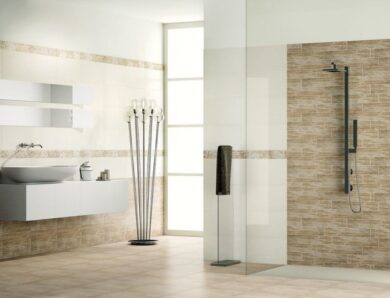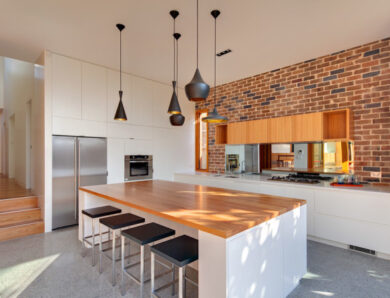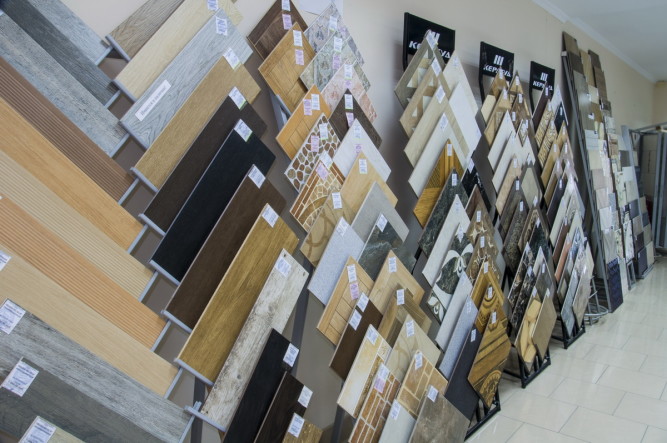How to lay tiles in a wooden house: features of laying
It is important to know when repairing a wooden house, how to put a tile on such a special material. Wood has excellent properties, affect not only the process of facing, but also on the further operation of the coating. However, you can't do without tiles in the house, so you need to find a way out of this situation.
Installation of a tile on the basis from wood has a number of differences
Features of a wooden surface
Laying ceramic tiles in a wooden house is a special process. Conditions of such premises differ from standard, because wood has some specific characteristics:
- Dynamics. When the temperature or humidity changes, the wood moves and takes on a different volume, expanding or withering.
- Shrinkage. It happens over time, which affects the shape and condition and walls, and floors.
- Moisture susceptibility. Any increase in humidity affects the wood, especially relevant for the bathroom and kitchen. It is important to provide good hydro- and vapor barrier.
- Prone to damage. At constant wetting the wood rots, mold, affected by the fungus. Insects are also the enemy of this material. Prevent damage by carrying out a decent antiseptic treatment and coating the boards with a protective layer, example, varnish.
There are a number of specific characteristics to consider when laying ceramic tiles in a wooden house
If the housing is built recently, it is recommended to wait for the end of the active phase of shrinkage before starting the tiling. This will avoid shifting the coating, so, maintain integrity.
Because laying tiles on a wooden floor or wall is a must, not a whim, it is important to know the basic rules of such work.
Required materials and tools
Consider, how and what is better to glue a ceramic tile to a tree. Special materials are used to work with such surfaces. Use standard mixtures, but then limit the contact of the tile cladding with the wooden base, which leads to unnecessary costs, and takes up part of the area of the room.
At installation of a tile use:
- Cement mortar. Standard cement-sand mixture. Because it is a wooden base, it is improved by liquid glass.
- Adhesives with polymer additives. Such modifiers increase the elasticity of the composition and have better adhesion.
- Special wood glue for tiles. A separate category of building materials. It provides waterproofing and retains the ability to shift the base without the risk of destroying the new coating.
Types of mixtures for laying tiles on wood
You will also need the following tools and materials:
- toothed and rubber spatula;
- zatirka;
- primer;
- capacity for the mixture;
- crosses in the seams;
- mounting foam;
- waterproofing;
- finishing materials.
surface preparation
Before sticking tiles to the tree perform a number of works. If under normal conditions are limited to a modest leveling of the surface and primer, here it is necessary to carry out some more manipulations.
The first step is to inspect the wood flooring. This is especially true for the floor. First, remove the rough boards and check the condition of the load-bearing elements, if the logs are rotten, they are replaced. It is recommended to fill in the free space of expanded clay to improve thermal insulation.
Wooden elements are also treated with antiseptic moisture-repellent impregnation. Pre-remove a layer of old paint and varnish. After drying, the front cover is installed in place.
The best option -application of additional substrate, which compensates for the dynamism of wood. Moisture-resistant plywood or gypsum plasterboard is often used. Attach them to the frame or to the walls and floor. They are also carefully grounded. The mixture should be deep penetrating and form an additional protective film.
Preparing the base for laying tiles on a wooden surface
floor facing
First of all, take care of the flooring. Consider in detail the sticker of the tile to the wooden surface. It is recommended to make a screed in addition to plywood flooring, having previously provided waterproofing of a floor. To close joints and crevices, but keep the possibility of movement of the flooring when conditions change, it is recommended to use mounting foam, it will serve as a kind of compensator. Membrane polymer waterproofing is additionally spread on top of the base. Pieces of material overlap and fasten together with adhesive tape.
After that, pour a small layer of concrete screed. Special mixtures are on sale today, designed for wooden surfaces, differing in elasticity even in the frozen form and do not crack at the movement of the basis. After drying, the concrete is primed.
Stages of finishing a wooden surface with ceramic tiles
Now let's start facing the floor. Laying of a tile is carried out according to a standard technique. In the kitchen, it is recommended to start installation from a far-sighted corner or from the middle of the room. In the latter case, divide the surface by 4 parts from the central point and process each zone separately. After installation, be sure to coat the seams with a resin-based mixture or latex mastic.
Wall decoration
Laying tiles on the surface of wooden walls is also better after the construction of an additional layer in the form of plywood or moisture-resistant drywall. Otherwise, the tile will fall off over time.
If the bathroom is next door to the living space, take care of the waterproofing and vertically. This will protect against excess moisture.
Laying tiles on the walls of a wooden house
The work is carried out on a carefully prepared and primed surface. If space in the room is limited, instead of using plywood, joints and cracks are filled with foam, and from above level a covering with a small layer of plaster. Here it is also important to use elastic mixtures.
Laying tiles begins with the second row. Advancing in small areas. It is recommended to increase the layer of adhesive solution, inflicting it on the walls, and on the tile itself, this will give him extra space to move. Fix the gaps with crosses, on average, their thickness should be 3 mm. Seamless stacking in a wooden house is taboo. In this case, the elements will overlap when changing the volume of the base. The first row is the last, it often consists of threaded elements. Seal the joints with silicone sealant, and smear the seams with grout.
Facing a bathroom or kitchen with tiles in a wooden house is not a problem if you know the intricacies of such work. If you follow the rules and regulations, the coating will be securely fixed on the surface and will not deteriorate over time.



